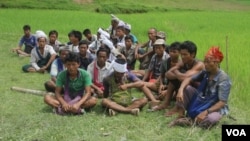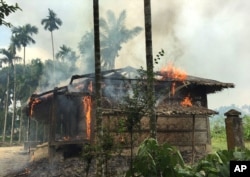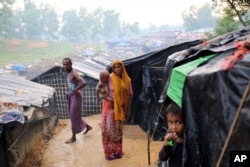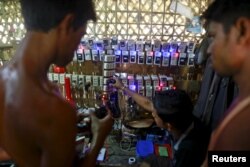Human rights groups and Rohingya community news outlets say they are facing a crisis in gathering detailed information about the Myanmar military crackdown in Rakhine, largely because a 5-year-old network of Rohingya "mobile phone reporters" has become largely dysfunctional.
Rohingya spokespeople around the world claim this has led to a lack of accurate reporting about what the Myanmar military has been doing in Rakhine.
Rohingya volunteer mobile phone reporters, or mobile reporters, are young community members who have used their mobile phones to document alleged abuses in Rohingya villages in Myanmar, also known as Burma, and send the information out of the country using the internet.
Rohingya refugee Jafar Arakane, who edits the community portal Arakan Times, said 90 percent of the mobile reporters who used to supply information to him from Rakhine have become inactive since the end of August, after the Myanmar military intensified “clearance operations” in the region.
“In the name of clearance operations the Burmese military are indulging in arson, rapes and killings of the Rohingya. Among all anti-Rohingya pogroms in Burma in the past decades, the current spell of violence has been the most horrifying. But, the trickle of information from Arakan being very low this time mostly because of the absence of our mobile reporters, our coverage of the violence is quite poor,” said the Saudi Arabia-based Arakane.
Myanmar’s army, and the civilian government led by de facto leader Aung San Suu Kyi, have strenuously denied allegations that its forces are carrying out atrocities against civilians, maintaining they do their utmost to avoid collateral damage and insisting that any violations will be investigated if proper evidence is brought to them. Diplomatic representatives abroad have also refuted allegations of ethnic cleansing.
With most of the Rohingya villages in northern Rakhine being deserted, most mobile reporters have been forced to flee with everyone else to Bangladesh, said Ko Ko Linn, a Bangladesh-based Rohingya community leader.
“Some of them have gone missing and we fear they might have been killed along with other Rohingya men,” Linn told VOA. “A few of them are perhaps still there in Arakan [Rakhine]. But, they are not in a position to work, as needed.”
The Rohingya spokespeople say there have been few reporters from recognized news organizations on the scene to report what is going on. The Myanmar government has restricted media access to the region apart from organized press tours with government escorts.
Start of a network
In June 2012, an alleged gang rape of a Buddhist woman by Rohingya Muslims triggered communal riots between the two communities in Rakhine state. As Myanmar declared a state of emergency and called in the military to control the riots, Rohingya community leaders complained of torture and abuses by the forces. The community’s leaders claim that security forces supported the Buddhist rioters in attacks against the Rohingya.
Allegations also surfaced then that the Myanmar media blacked out the news of abuses.
Young Rohingya community members in Rakhine were mobilized to discreetly gather evidence of the abuses using their mobile phones to send them out of the country through the internet and social media, Linn said.
“We mobilized the Rohingya youths in Rakhine to use their mobile phones to collect reports of the abuses with photos, videos and audio clips, the way the media reporters do. The response was massive from their side and we soon succeeded to establish a smart network of young people who stood in as reporters in Rohingya villages,” Linn said.
When violence broke out in Rakhine last year, the Rohingya mobile reporter network allegedly sent out “good reports” of the military-led attacks in Rohingya village across Rakhine and the world knew what abuses took place there, Linn said.
“Since August, the anti-Rohingya violence in Arakan has become more severe. But, we do not have most of our mobile reporters at work there. So, many violent incidents of torture, killing etcetera in Rohingya villages are going unreported,” he said.
Outside media
After the Myanmar army began a crackdown in October last year to “flush out Rohingya militants” following a deadly attack on a police outpost, charges of rapes, killings and arson were leveled against the soldiers in the Rohingya village but outside media has been restricted in their access to the area.
As a result, the Rohingya leaders claim the true story of the crackdown has not been getting out to the world.
The Myanmar government has taken groups of reporters to the region in recent weeks and has denied charges of systematic abuses against the Rohingya. But because of the security situation, reporters say they are not able to freely move about the area and gather information.
With few news reports coming from Rakhine, the services of the mobile reporters have been highly sought after by international human rights groups and the media, said Ireland-based Rohingya refugee Mohammad Rafique.
“Several international human rights groups and correspondents collected news about human rights abuses and other related information from Arakan using the Rohingya mobile network. They all are being starved of information from Rakhine now,” said Rafique, who edits the Rohingya news portal www.stateless.com.
Several human rights groups have identified the mobile reporters as Rohingya human rights monitors.
Phil Robertson, deputy Asia director of Human Rights Watch, said the bravery and skill of the Rohingya rights monitors documenting violations in their area, and their ability to pass their reports, photos and videos out through networks to the wider world played a very important role in showing what happened in the violence last year, and during the first few days after August 25.
"The eyes and ears of these Rohingya monitors were the last witnesses to what is happening because the humanitarian agencies, journalists, and international monitors are still blocked from access," he said.
"The Burma government has totally shut down these areas, and they are systematically violating the rights of the Rohingya - and no one is there to see it any more."















